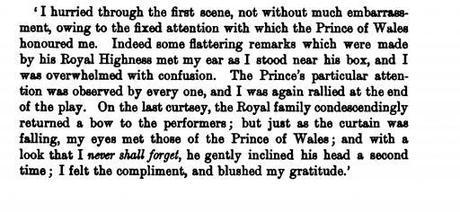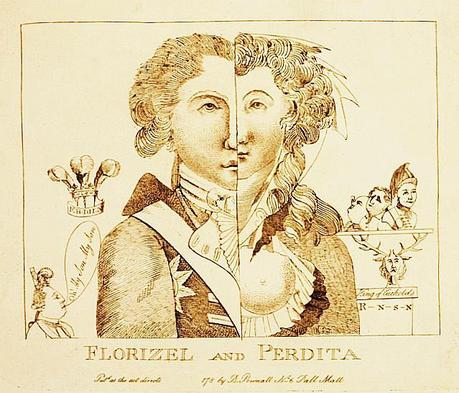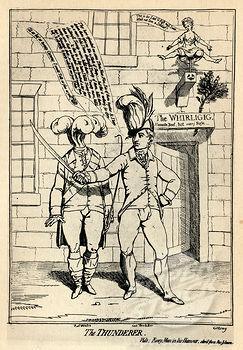Mary “Perdita” Robinson and George “Florizel“ Prince of Wales
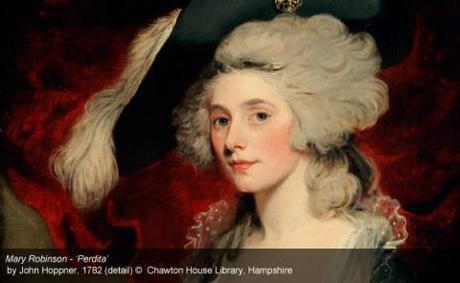
“Every event of my life has more or less been marked by the progressive evils of a too acute sensibility. “ Mary Darby Robinson, The Memoirs of Mary Robinson
Mary Robinson (nee Darby) was born in 1758, the third of five children. When Mary was seven, her father Captain Darby went to Labrador to try to establish a whaling station, leaving his wife and family in Bristol while taking his mistress with him. Captain Darby provided scanty support for his wife and children, forcing them to fend largely for themselves. Although she received a sporadic education, while in Bristol Mary attended a school run by the sisters of playwright Hannah More and later attended the seminary of Meribah Lorrington in Chelsea, but the schoolmistress had a predilection for drink which eventually forced the school to close. In desperation to support her family, Mary’s mother started her own school at which fourteen-year-old Mary taught English, however, Captain Darby was opposed to the notion and during one of his brief sojourns at home, closed the school, which was his right by law. According to English law (See Caroline Norton, English Laws for Women) any property or business under his wife’s control was legally his to do with it as he chose.
Somehow Mary contrived to attend a finishing school run by a Mrs. Hervey who brought Mary to the attention of David Garrick, actor and manager of the Theatre Royal, Drury Lane. Although she was only fifteen, Garrick was so impressed with Mary’s talents that he proposed to put her on stage.
“Garrick was delighted with everything I did. He would sometimes dance a minuet with me, sometimes request me to sing the favorite ballads of the day; but the circumstance which most pleased him was my tone of voice, which he frequently told me closely resembled that of his favorite Cibber.”
Never shall I forget the enchanting hours which I passed in Mr. Garrick’s society; he appeared to me as one who possessed more power, both to awe and to attract, than any man I ever met with. His smile was fascinating, but he had at times a restless peevishness of tone which excessively affected his hearers; at least it affected me so that I never shall forget it. ” (Mary Darby Robinson, The Memoirs of Mary Robinson, pp. 37-38.)
Mary was now being courted by a young man named Thomas Robinson who presented himself as a law clerk of respectable family, but insisted on a secret marriage that took place on April 12, 1774. Unfortunate for Mary, Robinson had sadly misrepresented both his family background and his prospects for his was a bastard son with no expectations.
“Opposite to the house in which I resided lived John Vernon, Esq., an eminent solicitor. I observed a young inmate of his habitation frequently watching me with more than ordinary attention. He was handsome in person, and his countenance was overcast by a sort of langour, the effect of sickness, which rendered it peculiarly interesting. … During the remainder of the evening, Mr Wayman expatiated on the many good qualities of his friend, Mr. Robinson: spoke of his future expectations from a rich old uncle; of his probably advancement in his profession; and, more than all, of his enthusiastic admiration of me.” (Mary Darby Robinson, The Memoirs of Mary Robinson, pp. 38-39)
The Robinsons, however took on an extravagant lifestyle that by far exceeded their means. Mary insisted on being seen in all the modish places and dressed in the height of fashion while Robinson gambled with his set of fast-living, hard-drinking friends and took on a mistress while allowing his friends to openly pursue his wife.Eventually the creditors caught up with them resulting in Thomas, Mary and the baby lived in King’s Bench prison for over a year where Mary earned a little money by copying legal documents and penned a volume of poetry which she sent to Georgiana, the Duchess of Devonshire. Mary dedicated Captivity, A Poem: and Celadon and Lydia, A Tale (1777) to the Duchess of Devonshire.
Following 15 months in prison, Mary returned to the theater in 1776, appearing as Juliet at Drury Lane to great critical acclaim, but her most infamous role was that of Perdita in A Winter’s Tale which led to a command performance for the royal family. Included in the audience was the 17-year-old Prince of Wales (later King George IV) who was bedazzled by her.
According to her memoirs, Mary had already received offers of “protection” from the Duke of Rutland, one of the royal dukes, and an unnamed marquess, but had refused them all to maintain her “good name.” The prince, however, was most determined to make her his mistress and sent his friend Lord Malden to negotiate on his behalf.He delivered to Mary a letter addressed to “Perdita” and signed “Florizel” but Mary was dubious about the authenticity of the letter. According to Mary, the Prince requested that she attend the Oratorio where he would prove he was the author of the letter.

An entertainment in Vauxhall Gardens in c.1779 by Thomas Rowlandson. Elizabeth Billington is singing from the balcony. The two women in the center are Georgiana, Duchess of Devonshire and her sister Lady Duncannon. The man seated at the table on the left is Samuel Johnson, with James Boswell to his left and Oliver Goldsmith to his right. To the right the actress and author Mary Darby Robinson stands next to the Prince of Wales, later George IV
The exchange between the actress and the prince was reported the next day:

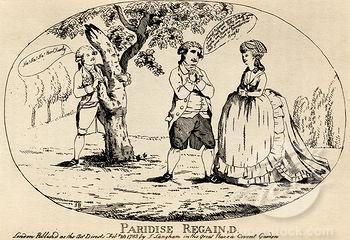 From this point onward Florizel and Perdita carried out an amorous and not-so-secret correspondence with Lord Malden still acting as intermediary.
From this point onward Florizel and Perdita carried out an amorous and not-so-secret correspondence with Lord Malden still acting as intermediary.
According to Mary:”There was a beautiful ingenuousness in his language, a warm and enthusiastic adoration expressed in every letter ” which interested and charmed her.
Nevertheless, Mary did not immediately jump into an affair which only seemed to fan the flames of his ardor. Prince George sent her his portrait in miniature (surrounded by diamonds) and accompanied by a small paper heart upon which he had written Je Ne change qu’en mourant on one side and “Unalterable to my Perdita through life” on the other and proposed that she come to his apartments disguised in male clothing. Mary once more refused. Their correspondence still continued but now in addition to his letters vowing eternal affection, the prince sent a bond of £20,000, to be paid when he came of age. Shortly after this event, Mary succumbed to the Prince’s wishes to become his mistress, an event the paparazzi followed with glee:
“The writer has paid the highest compliments to the young lady in question, who could make a conquest in the heart of a young and illustrious personage, at the very moment when he is surrounded by all the beauties of the British Court, vying with each other to capture and ensnare him.” (anonymous, Morning Post, July 22, 1780).
“Fortune has again smiled on Perdita; on Sunday she sported an entire new phaeton, drawn by four chestnut-coloured ponies, with a postillion and servant in blue and silver liveries. The lady dashed into town through Hyde Park turnpike at four o’clock, dressed in blue great coat prettily trimmed in silver; a plume of feathers graced her hat, which even Alexander the Great might have prided himself in.” (Morning Herald, June 12, 1781).
The affair, however, lasted less than a year with the Prince’s defection leaving Mary deeply in debt, the price having made no financial provision for his ex-mistress and even refused to honor the 20,000 pound note he had previously given her. With her reputation already in shreds, Mary resorted to extortion by demanding £25,000 for the return of the prince’s letters but settled for £5,000, paid by George III “to get my son out of this shameful scrape.” Mary later obtained a further £500 annuity in return for the surrender of the Prince’s bond.
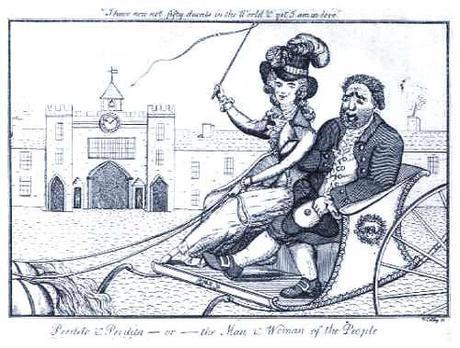
Caricature of Mary Robinson and Charles James Fox
Lord Malden, the Prince’s original emissary, was now Mary’s most frequent companion, and her lover. Rumor suggests she was mistress to Charles James Fox, who negotiated the annuity for her.
The great Love of Mary’s life, however, turned out to be a half-pay cavalry officer named Banastre Tarleton who joined the Prince’s circle upon his return from the American war in 1782. The affair ironically began when Lord Malden bet 1000 guineas that Mary would be true to him if Tarleton tried to seduce her. Several weeks later, Tarleton won both the bet and Mary’s affections. Although she was furious when she later learned of the wager, Tarleton would become the great love of her life. Their relationship would continue for the next 15 years.
Always the darling of the broadsheets, Mary’s subsequent affair was satirized:
Caricature of Lord Malden, Colonel Tarleton and Mary Robinson
“Yesterday, a messenger arrived in town, with the very interesting and pleasing intelligence of the Tarleton, armed ship, having, after a chace of some months, captured the Perdita frigate, and brought her safe into Egham port. The Perdita is a prodigious fine clean bottomed vessel, and had taken many prizes during her cruize, particularly the Florizel, a most valuable ship belonging to the Crown, but which was immediately released, after taking out the cargo. The Perdita was captured some time ago by the Fox, but was, afterwards, retaken by the Malden, and had a sumptuous suit of new rigging, when she fell in with the Tarleton. Her manoeuvering to escape was admirable; but the Tarleton, fully determined to take her, or perish, would not give up the chace; and at length, coming alongside the Perdita, fully determined to board her, sword in hand, she instantly surrendered at discretion. ” (Morning Post, September 21, 1782).
Incapacitated by illness, Mary Robinson spent the rest of her short life in a successful literary career. She died at age forty-two.
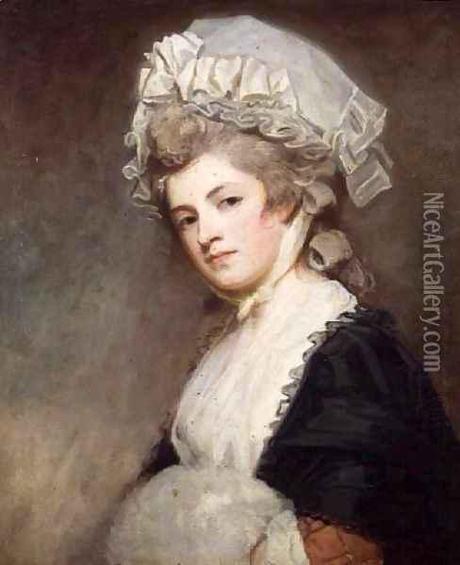
Mary “Perdita” Robinson circa 1781
Mary Robinson’s ill-fated affair with the Prince of Wales served to inspire a similar incident between my fictional actress Phoebe Scott and Prince George in my erotic romantic comedy A WILD NIGHT’S BRIDE written as Victoria Vane.
References:
Comedy Queens of the Georgian Era, John Fyvie,Archibald Constable and Company, London 1906
http://digital.library.upenn.edu/women/robinson/biography.html
http://scandalouswoman.blogspot.com/2011/12/scandalous-women-in-london-first.html
